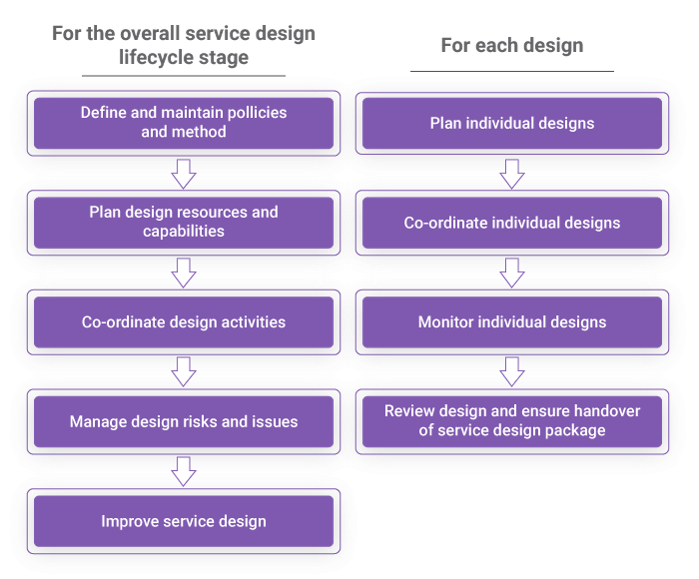
It is an established fact that the ITIL service lifecycle has 5 stages – service strategy, service design, service transition, service operation, and continual service design. All these stages are equally important to help ensure that IT services are delivered of the highest quality possible and that the customer is kept happy. However, among these stages, the service design stage is of more significance than the other stages.
Most organizations tend to skip the service design stage completely. They plan their services (service strategy) and then directly get on to implementation (service transition and operation). Service design is ignored as a process in itself. This eventually leads to several adverse effects,
-
- The customer is not happy with the level of service being provided.
- Feature modification and enhancement requests post-implementation.
- Last-minute fixes to service process and workflow.
- IT staff require training to provide better service.
These aspects are not normal characteristics of a successfully delivered service. They only go on to represent a poorly planned service that was implemented without the necessary service blueprint in place.
The Objective of Service Design
Understand why ITIL Service Design is most important for IT services. The main purpose of service design is to plan and design IT services together with the governing IT practices, processes, and policies to realize the service provider’s strategy, and to facilitate the introduction of these services into supportive environments ensuring quality service delivery, customer satisfaction, and cost-effective service provision.
There are 4 key principles upon which service design functions are based.
- People (stakeholders)
- Processes
- Products (technology, tools, services)
- Partners (vendors, manufacturers)
All these principles form the foundation for the 5 design aspects of service design.
1. Service Solutions:
All the functional requirements, resources, and capabilities are needed and agreed upon.
2. Service Management Systems and Tools:
To ensure consistency with other services and guarantee that supporting and dependent services are adequate to maintain ongoing reliable service delivery.
3. Technology Architecture and Management Systems:
To ensure they are consistent with the new service and are suitable to operate and maintain it.
4. Processes:
To ensure that the process, roles, and responsibilities are adequate to operate, support, and maintain the new or changed service.
5. Measurement Methods and Metrics:
To ensure that the right parameters are set which will help assess the quality of service provided
All these design elements need to be documented and tracked to ensure that they are being created for each aspect of a new service or changed service. This document is called the Service Design Package. The service transition stage will make use of this service design package to begin implementing the service.
The indispensable nature of the service design stage to the service lifecycle lies in the fact that service design lays the groundwork on which the service is built and this design blueprint consists of the following elements.
Service Design Blueprint
1. Service Catalogue:
The purpose of the Service Catalogue Management process is to provide and maintain a single source of consistent information on all operational services and those being prepared to be run operationally, and to ensure that it is widely available to those in the organization who are authorized to access it.
2. Service Level Management:
The SLM process is responsible for agreeing and documenting service level targets and responsibilities within Service Level Agreement (SLA) and Service Level Requirements (SLRs) for every service and related activity within IT. This process ensures that all current and planned IT services are delivered to agreed and achievable targets.
The Operational Level Agreement (OLA) is also a part of this process. An OLA is an agreement between an IT service provider and another part of the same organization that assists with the provision of services – for instance, a facilities department that maintains the air conditioning, or a network support team that supports the network service.
3. Capacity and Availability Management:
The purpose of the Capacity Management process is to ensure that the capacity of IT services and the IT infrastructure meets the agreed capacity and performance-related requirements in a cost-effective and timely manner.
Availability on the other hand is the ability of a Configuration Item or IT Service to perform its agreed function when required. Availability is usually calculated as a percentage. This calculation is often based on agreed service time and downtime. It is best practice to calculate availability using measurements of the business output of the IT service.
4. IT Service Continuity Management:
IT Service Continuity Management supports the overall business continuity by ensuring and managing the risks that could seriously affect IT services. The IT service provider can always provide minimum agreed business continuity-related service levels.
5. Information Security Management:
The value of information security can never be stressed enough in a service environment. The Information Security Management process aligns IT security with business security and ensures that the confidentiality, integrity, and availability of the organization’s assets, information, data, and IT services always match the agreed needs of the business.
6. Supplier Management:
Third-party suppliers play a key role in the successful delivery of an IT service when managed efficiently. The Supplier Management process obtains value for money from suppliers and provides seamless quality of IT service to the business by ensuring that all contracts and agreements with suppliers support the needs of the business and that all suppliers meet their contractual commitments.
These 6 processes ensure that the service blueprint covers all bases in terms of the 5 design aspects. When the design blueprint is solid, it provides the perfect starting point for the operational guys to start implementing the service. The value of the service design process to an IT service can be summed up in the 4 following benefits.
-
- Improvement of quality and consistency of service
- Ease the implementation of new or changed services
- Improve service alignment with the organization’s goals
- Reduce total cost of ownership
Design Coordination in ITIL
The final process in the ITIL service design stage of the ITIL Lifecycle for services is the design coordination process. It is a useful part of service design that has been newly added in the revised ITIL V3 edition.
The main purpose of design coordination is to make sure that the objectives of the design stage are fulfilled as per the requirement. It aims to coordinate all the service design activities, processes, and resources.
Objectives of Design Coordination in ITIL
The objectives of the design coordination process are:
-
To make plans and organize all the design activities
-
To produce Service Design Packages based on change requests and service charters.
-
To make sure that only the appropriate service designs are produced and transferred to service transition as previously agreed upon.
-
To validate the uniformity in the establishment of IT services, service management information systems, processes architectures, metrics, and technology.
-
To manage the interfaces with service strategy and service transition
-
To increase the efficiency and efficacy of the activities and processes of service design.
-
To effectively manage all the design activities across various projects, changes, support teams, and suppliers in addition to supervising resources and schedules.
-
To ensure consistency in the design of the following in order to meet the present and future needs and requirements of businesses that are always evolving:
-
Appropriate services
-
Service management information systems
-
Architectures
-
Technology
-
Processes
-
Information
-
Metrics
-
Scope of Design Coordination in ITIL
All design activity comes under the scope of design coordination. The scope of the design coordination varies from one organization to another as each company will have different objectives, visions, and strategies.
-
Certain design efforts will be a part of a project and others will be managed solely via the change process, without a formally defined project.
-
Design coordination needs to pay maximum attention to major changes.
-
Every organization needs to properly define the level of attention that needs to be applied to each design in design coordination.
-
The interaction between the design and processes, review, measurement, and improvement of service design also come under the scope of the design coordination process.
Value of Design Coordination in ITIL
The design coordination process makes sure that the desired business outcomes are provided by consistent quality solution designs and service design protocols.
Process Activities of Design Coordination in ITIL
The process activities under design coordination come under two categories:
-
Activities that are related to the overall service design lifecycle stage.
-
Activities are related to each individual design.
The stages of the process activities are shown in the flowchart below.
Sub-Processes of the Design Coordination Process
1. Design Coordination Support
The aim of this process is to manage and develop service design resources and competencies in order to make sure that a reliable and steady approach is implemented across all the service transition projects.
2. Service Design Planning
The aim of this process is to make detailed plans of all design activities to ensure that all relevant topics are taken into account during service design.
3. Service Design Coordination and Monitoring
The aim of this process is to coordinate the design activities which are performed by multiple service design processes and to find out if the services which are newly implemented or changed can be provided economically.
4. Technical and Organizational Service Design
The aim of this process is to find out the way in which a new service will be provided from an IT perspective, by specifying the technical infrastructure which needs to be created along with the organizational changes which are required.
5. Service Design Review and Request for Change Submission
The aim of this process is to provide the service design package for a final review and start the implementation of the service by submitting a formal RFC (Request for Change).
Challenges of Design Coordination in ITIL
The challenges involved in the design coordination process are:
-
Maintaining high-quality Service Design Packages throughout the complicated landscape consisting of different businesses, services, and infrastructure.
-
To ensure that adequate resources are allocated to design coordination activities.
-
To develop common practices which produce the high-quality designs which are needed, without bringing in unwanted bureaucracy.
Risks of Design Coordination in ITIL
The following risks are encountered while implementing design coordination:
-
A lack of available skill and knowledge
-
An absence of involvement from the business in question
-
Business priorities and requirements that are poorly defined or not clearly mentioned.
Conclusion
These are the reasons why it is important to spend time and effort in getting the service design process right. It will ensure that your service implementation happens seamlessly at the optimum costs and that the service is delivered in such a way that it meets the expectations of the customer.
Learn more about Service Management best practices through Invensis Learning’s IT Service Management certification training on ITIL V4 Training and Certification, SIAM Foundation, SIAM professional, VeriSM, etc.
















